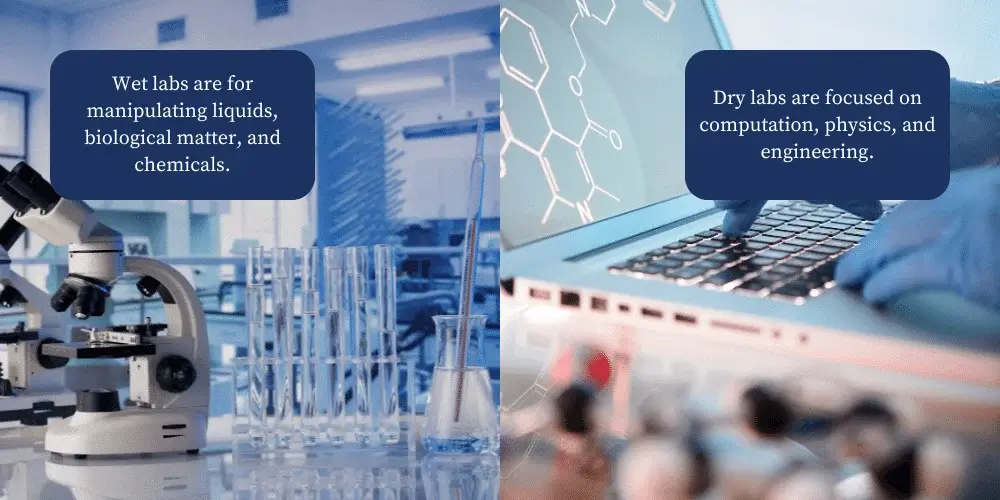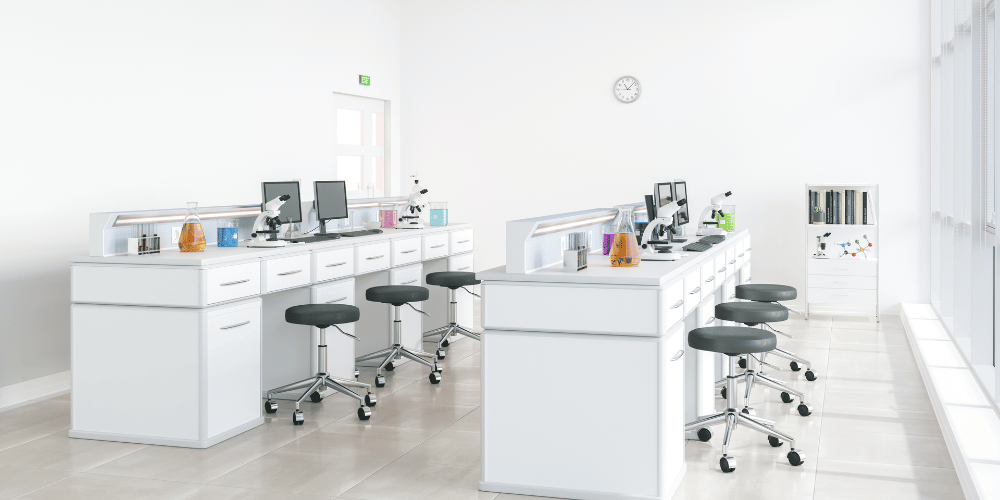Wet Labs vs Dry Labs: What’s The Difference?

As advancements in technology and testing evolve, the distinction between wet labs vs dry labs remains essential, each serving unique purposes with specific design needs.
The progress in computational technology has significantly broadened the scope of scientific testing. The evolutions of complex wet and dry laboratories have been possible due to advanced computer networks and have allowed a significant leap in scientific capabilities.
At IPG, our expertise lies in tailoring the perfect space for your scientific endeavors. With over a decade of experience in lab-based industries, I hope to clarify the differences between wet and dry labs. Here, we’ll explore the distinct functionalities and designs that set wet laboratories apart from dry laboratories, and how they often work in tandem in the modern scientific landscape.
What is a Wet Lab? Wet Labs Explained
A wet lab is the type of research laboratory in which experiments are performed with liquid substances and, usually, biological samples. These types of labs are designed to handle chemical and potential wet hazardous products. All researchers involved in wet lab research must possess skills and knowledge of wet lab techniques and safety procedures.
Wet lab research is an essential part of scientific discovery, as it allows scientists to directly manipulate and study physical properties in the real world. Consequently, wet labs must be carefully designed and operated in order to ensure the safety of both researchers and the general public.
Types of research conducted in wet laboratories include:
- Analysis of biological specimens
- Pathological studies
- Research in molecular and cellular biology
- Studies in organic and physical chemistry
- Cultivation of tissue cultures
Wet Lab Design Features
- Complexity: Wet labs have more intensive design requirements due to:
- Handling and testing of biological materials
- Storage of samples
- Safety and Administration: Considerations include:
- Safety measures for testing personnel
- Administrative support for operations
- Intensive Design Elements: The design of a wet lab involves careful consideration of:
- Layout of the space
- Selection of equipment and furniture
- Lighting is critical
- Impact on Work: These elements affect:
- Efficiency, consistency and accuracy of laboratory work
- Higher Design Level: Wet labs necessitate a more intricate level of design compared to other lab types.

What is a Dry Lab? Dry Lab Explained
A dry lab is a laboratory where computational and mathematical analyses are done on electronic equipment like computers and other digital devices. These labs are specially designed to store large electronic instruments. These laboratories are built for analytical purposes and require a proper temperature and humidity control system. Dry labs generally have fewer risks than traditional wet laboratories, as there are no hazardous chemicals or other materials present.
However, it is important to follow safety protocols when working in a dry lab, as electrical equipment can pose a fire or shock hazard if not handled properly. They usually have a higher initial cost than traditional laboratories, as they require specialized equipment and an uninterrupted power supply. However, the long-term costs of operating a dry lab are often lower, as consumables like pipeline supplies and growth media are not necessary and there is rarely need to purchase or dispose of hazardous materials.
Types of research conducted in dry laboratories include:
- Evaluation of research methodologies
- Hardware development
- Comprehensive data analysis
- Development and implementation of coding
- Interpretative analysis of textual content
Dry Lab Features
- Workstations: The primary furniture in a dry lab is the workstation, which typically includes:
- A Central Processing Unit (CPU)
- One or more monitors
- A printer
- Mobility: Unlike wet labs, equipment in dry labs is not fixed. It’s often placed on:
- Rolling carts for easy mobility
- Flexibility: This movable setup allows for greater flexibility in workspace configuration.
- Environment Control: Dry labs usually require less ventilation than wet labs, aiding in easier temperature and humidity control
- Comfort: As a result, dry labs often provide a more comfortable working environment.
Key Differences Between Wet Lab and Dry Lab
While both wet and dry labs serve the purpose of conducting tests in a controlled setting, their similarities largely stop there.
Wet Lab Characteristics:
- The core of wet lab activities involves working with tangible samples, such as:
- Chemicals and liquids
- Biological samples
- Pharmaceuticals and various fluids
- Essentially, wet labs are dedicated to experimenting with “wet” materials.
Dry Lab Features:
- In contrast, dry labs focus on:
- Data-driven testing and analysis
- Utilization of coding and computer systems
- Typical activities in a dry lab include:
- Modeling and analytical tasks
- Dry labs are geared towards the examination of “dry” materials, primarily data and digital models.
Summary
While both types of labs are important for scientific discovery, each has its own strengths and weaknesses. Wet labs are ideal for experimentation and hands-on learning, while dry labs are better suited for theoretical research and data analysis. Ultimately, both types of labs play a vital role in the scientific process.
Knowing the specific requirements of your research space is critical to the long term performance of your facilities. At Innovation Properties Group we have the skills to get you started in the right trajectory. If you’re based in the Bay Area, or are planning to be, we can help you find the perfect lab space for your needs – just get in touch!




